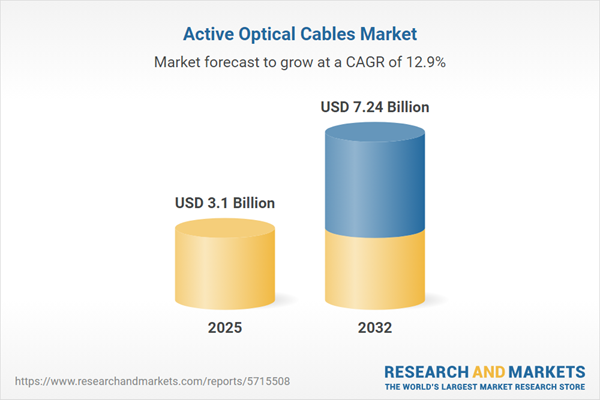Speak directly to the analyst to clarify any post sales queries you may have.
The active optical cables market is redefining enterprise connectivity by delivering reliable, high-speed data transfer for organizations with complex, distributed IT landscapes. These advanced solutions enable senior decision-makers to address evolving business requirements and increasing network demands with confidence.
Active Optical Cables Market Snapshot
The global active optical cables market is positioned for robust growth, projected to expand from USD 2.74 billion in 2024 to USD 3.10 billion in 2025, ultimately reaching USD 7.24 billion by 2032, with a compound annual growth rate of 12.91%. Key factors fueling this expansion include rising demand for high-bandwidth infrastructure, deeper penetration within telecom and cloud computing environments, and ongoing enterprise investments in upgrading network architectures. These trends are accelerated by the pace of digital transformation and the shift toward hybrid workplace models, establishing active optical cables as a critical component for high-availability, future-ready connectivity across diverse industries.
Scope & Segmentation of the Active Optical Cables Market
- Transmission Distance: Solutions include both long-haul and short-range options, supporting deployment versatility in centralized data centers, distributed edge computing sites, and adaptable on-premises facilities.
- Cable Type: Product variants span multi mode and single mode cable types, ensuring suitability for localized data connections as well as broad-scale network enhancements in advanced infrastructure projects.
- Application: Use cases cover hyperscale data centers, telecom backbone networks, enterprise IT systems, carrier-grade infrastructure, and colocation centers where uptime and continuity are essential.
- Data Rate: Offerings support enterprise requirements for speeds ranging from 10G up to 100G, simplifying the path for organizations expanding to higher capacity networks.
- Connector Type: Standard interfaces such as LC, MPO, and QSFP are available, ensuring compatibility and straightforward integration across multiple network platforms.
- Regional Coverage: The market extends across the Americas, Europe, Middle East & Africa, and Asia-Pacific, reflecting diverse regional innovations, compliance requirements, and strong adoption in countries like China, India, Japan, and Southeast Asia.
- Company Coverage: Leading providers include Broadcom Inc., II-VI Incorporated, TE Connectivity Ltd., Amphenol Corporation, Corning Incorporated, Furukawa Electric Co., Ltd., Sumitomo Electric Industries, Ltd., Hitachi Cable, Ltd., Luxshare Precision Industry Co., Ltd., and Senko Advanced Components, Inc., each advancing the sector through technological innovation and tailored solutions.
Key Takeaways: Strategic Insights for Enterprise Leaders
- Active optical cables form an essential technology foundation for digital transformation initiatives, supporting the development of scalable and agile IT infrastructure that can flex with business growth.
- Flexible system architectures enabled by these cables help organizations adapt to shifting workloads, optimizing operational performance and resource use.
- Advancements in optical component design and signal management techniques are improving network efficiency, thereby bolstering reliability under mission-critical conditions.
- Global deployment strategies require close alignment with local compliance mandates, varying technology adoption rates, and the importance of resilient supply chain planning.
- Collaborative partnerships with technology vendors facilitate integration of emerging networking capabilities, enabling smooth transitions during infrastructure updates or changes in market conditions.
- Procurement practices now prioritize cost control, adherence to environmental, social, and governance objectives, and compliance with international regulations for sustainable growth.
Tariff Impact: Navigating Policy Shifts
Recent shifts in U.S. tariffs on optical transceivers and semiconductor components are prompting enterprises to adapt procurement and supply chain approaches within the active optical cables market. Expansion of supplier networks, evaluation of nearshoring opportunities, and enhanced logistics planning are among the measures organizations are taking to minimize policy risk. Such proactive strategies help maintain operational continuity and support compliance in changing regulatory climates.
Methodology & Data Sources
This analysis combines in-depth qualitative research with rigorous quantitative data sourced from respected industry authorities. Integrated expert viewpoints and validated metrics equip senior leaders with practical, trustworthy guidance to inform investment and strategic decisions for active optical cables.
Why This Report Matters for Senior Decision-Makers
- Comprehensive segmentation and technical detail empower leadership to optimize procurement processes and ensure alignment with both regulatory complexities and shifting global supply chains.
- Fact-based insights guide organizations in building adaptable, compliant connectivity strategies that provide resilience and lasting business value amid rapid market evolution.
- The report’s recommendations connect technology adoption with sustainability targets, reinforcing competitive edge in dynamic environments.
Conclusion
This report equips senior executives with the insights needed to craft reliable, future-facing connectivity solutions aligned with enterprise goals and evolving market conditions.
Additional Product Information:
- Purchase of this report includes 1 year online access with quarterly updates.
- This report can be updated on request. Please contact our Customer Experience team using the Ask a Question widget on our website.
Table of Contents
3. Executive Summary
4. Market Overview
7. Cumulative Impact of Artificial Intelligence 2025
List of Figures
Companies Mentioned
The companies profiled in this Active Optical Cables market report include:- Broadcom Inc.
- II-VI Incorporated
- TE Connectivity Ltd.
- Amphenol Corporation
- Corning Incorporated
- Furukawa Electric Co., Ltd.
- Sumitomo Electric Industries, Ltd.
- Hitachi Cable, Ltd.
- Luxshare Precision Industry Co., Ltd.
- Senko Advanced Components, Inc.
Table Information
| Report Attribute | Details |
|---|---|
| No. of Pages | 198 |
| Published | November 2025 |
| Forecast Period | 2025 - 2032 |
| Estimated Market Value ( USD | $ 3.1 Billion |
| Forecasted Market Value ( USD | $ 7.24 Billion |
| Compound Annual Growth Rate | 12.9% |
| Regions Covered | Global |
| No. of Companies Mentioned | 11 |









